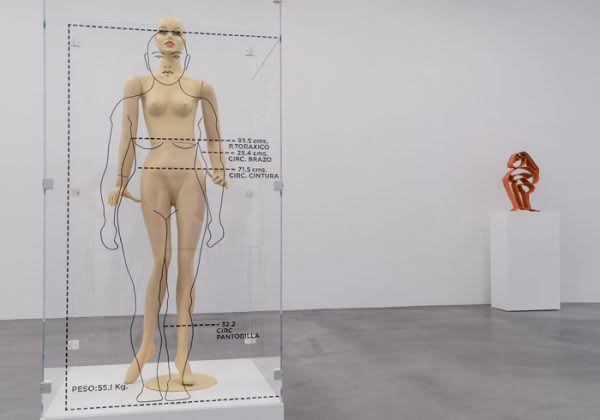Teresa Burga’s first retrospective in Switzerland covers an impressive range of work: from relatively conventional modernist paintings to playful Pop, from non-object-oriented interdisciplinary projects to work on paper, video, installation and sculpture. Born in 1935, this Peruvian conceptualist is a multifaceted, intellectual artist whose practice intersects with and draws on social science, architecture and mathematics. The four projects in the exhibition that most clearly exemplify her important contributions to the art of her country are Perfil de la Mujer Peruana (Profile of the Peruvian Woman, 1980–81), 4 Mensajes (4 Messages, 1974), Autorretrato. Estructura. Informe 9.6.72 (Self-portrait. Structure. Report 9.6.72, 1972) and Borges (1974/2017), all of which pursue an experimental scientific methodology, turning traditional aesthetics on their head by giving artistic form to data, while questioning, if not rejecting, authorship in favour of a collaborative approach found primarily in research contexts.
Burga’s international success has come relatively late, starting in 2011 with institutional solos in Europe and the US. As has been the trend in recent years, conceptual artists from the 1960s and 70s working in non-Western countries – Burga included – have been reclaimed for the art-historical canon, a familiar narrative being crafted about the difficult political conditions in which they produced groundbreaking work. This narrative has permitted Western institutions to read the work as resistant to dictatorial regimes, whether on the left or the right – art as freedom, a favourite mantra of contemporary art historians. This lack of distinction concerning the true nature of the Peruvian administration is illustrated in the oft-repeated moniker for the period of 1968–80, from which much of this work is drawn, as a ‘nationalist dictatorship’: a term that appears in the majority of press releases and discussions of Burga’s work, insinuating that her lack of artistic renown in her own country is the result of the period’s politically repressive character. However, her most impressive and political work, Profile of the Peruvian Woman, was completed in 1981, after the government of Francisco Morales-Bermúdez (1975–80) had begun to move the country towards democracy following the socialist military government of Juan Velasco Alvarado (1968–75).
Profile… is a ‘sociological research project produced with psychotherapist Marie-France Cathelat on the role and the ways of participation of middle-class women in the city’. Burga presents the results of their study via coloured graphs, a mannequin representing the size of the average woman and various other forms of writings on paper and charts, the latter mostly exhibited under glass and as a book originally published in 1981. And even during Velasco’s regime, Burga exhibited Self-portrait. Structure. Report. 9.6.72, a medical analysis of herself, also mostly composed of charts and graphs as well as a few photographs, which according to a 2014 interview ‘was attended by the ministers themselves, General Velasco’s wife, my mum, my aunt, they were all there, under State Security’.
According to a 1974 report by the Council on Foreign Affairs, after a few years of positive social transformations in the economy and education by ‘a generally unrepressive’ government that nationalised land and water-rights, a drastic change took place in national values, including the promotion of ‘the new Peruvian man’, dedicated to ‘solidarity, not individualism’. Burga’s Conceptualism, heavily influenced by her years at the School of the Art Institute of Chicago, where she went on a Fulbright in 1968, and her avant-garde activity in the Peruvian Arte Nuevo group from 1966 to 68, was more closely linked with characteristics of individualism than solidarity, despite the collaborative nature of some of her later projects. Conceptualism was a difficult language for the public to access, and remained elitist. It redefined the form that art took, subverting objecthood and traditional aesthetics in favour of ideas. It would have also been challenging for Peruvian officials – intent on developing a more equitable society, promoted through a universal democratic art – to see national value in these dematerialised forms; and accordingly they didn’t promote Burga’s work at the state level. Ironically, though, it is when dealing with Peruvian and Latin American themes, challenging perceptions of the role of women in society and revealing systems at work, that her works are most essential.
...
Read review at artreview.com.

